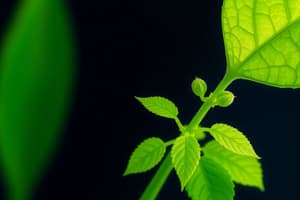Podcast
Questions and Answers
¿Quién es el descubridor del ciclo de Calvin?
¿Quién es el descubridor del ciclo de Calvin?
- Charles Darwin
- Gregor Mendel
- Albert Einstein
- Melvin Calvin (correct)
¿Qué es lo que absorbe la energía lumínica y la utiliza para producir carbohidratos en el proceso de fotosíntesis?
¿Qué es lo que absorbe la energía lumínica y la utiliza para producir carbohidratos en el proceso de fotosíntesis?
- Clorofila (correct)
- Cloroplastos
- Tilacoides
- Pigmentos
¿Por qué los plantas aparecen verdes a nuestros ojos?
¿Por qué los plantas aparecen verdes a nuestros ojos?
- Porque reflejan la luz verde (correct)
- Porque absorben la luz azul
- Porque absorben la luz roja
- Porque reflejan la luz amarilla
¿Cuál es el proceso que requiere los productos de las reacciones dependientes de la luz para funcionar?
¿Cuál es el proceso que requiere los productos de las reacciones dependientes de la luz para funcionar?
¿Qué es lo que se produce en el proceso de fotosíntesis?
¿Qué es lo que se produce en el proceso de fotosíntesis?
¿Cuál es el propósito principal del ciclo de Calvin en la fotosíntesis?
¿Cuál es el propósito principal del ciclo de Calvin en la fotosíntesis?
¿Qué pigmento absorbe la energía lumínica en las reacciones dependientes de la luz?
¿Qué pigmento absorbe la energía lumínica en las reacciones dependientes de la luz?
¿Dónde se llevan a cabo las reacciones dependientes de la luz en la fotosíntesis?
¿Dónde se llevan a cabo las reacciones dependientes de la luz en la fotosíntesis?
¿Cuál es el producto químico final principal de la fotosíntesis?
¿Cuál es el producto químico final principal de la fotosíntesis?
¿Qué es el producto químico que se produce en las reacciones dependientes de la luz?
¿Qué es el producto químico que se produce en las reacciones dependientes de la luz?
¿Cuál es la fuente de energía para el ciclo de Calvin?
¿Cuál es la fuente de energía para el ciclo de Calvin?
Study Notes
The Calvin Cycle and Chlorophyll: Understanding Photosynthesis
Photosynthesis is a fundamental process in the life of plants, algae, and some bacteria. It is the process by which these organisms convert light energy into chemical energy, primarily in the form of glucose and oxygen. The overall equation for photosynthesis is:
6 CO2 + 6 H2O + light energy → C6H12O6 (glucose) + 6 O2
This process occurs in two main stages: the light-dependent reactions and the Calvin cycle.
Light-Dependent Reactions
The light-dependent reactions take place in the thylakoid membranes of the chloroplasts. These reactions involve the absorption of light energy by chlorophyll and other pigments, which then convert the energy into chemical energy in the form of ATP (adenosine triphosphate) and NADPH (nicotinamide adenine dinucleotide phosphate). The light energy is absorbed by photosystems I and II, which are embedded in the thylakoid membranes. Photosystem I and II each use a different source of the low-energy electron supply, deliver their energized electrons to different places, and respond to different wavelengths of light.
The Calvin Cycle
The Calvin cycle, also known as the light-independent reactions, occurs in the stroma of the chloroplasts. It uses the ATP and NADPH from the light-dependent reactions to fix carbon dioxide and produce three-carbon sugars. This process involves the conversion of carbon dioxide into carbohydrates, which are then used by the plant to grow and live. The Calvin cycle is named after its discoverer, Melvin Calvin, and is a cyclical process that requires the products of the light-dependent reactions to function.
Chlorophyll
Chlorophyll is a pigment found in the thylakoid membranes of the chloroplasts. It is responsible for absorbing light energy and using it to produce carbohydrates in the process of photosynthesis. Chlorophyll absorbs light across a wide range of wavelengths, but it reflects green light, which is why plants appear green to our eyes.
In summary, photosynthesis is a complex process that involves the conversion of light energy into chemical energy, which is then used to produce carbohydrates and oxygen. The light-dependent reactions and the Calvin cycle work together in a cyclical process to provide the energy and building blocks needed for plant growth and survival.
Studying That Suits You
Use AI to generate personalized quizzes and flashcards to suit your learning preferences.
Description
Aprende sobre el proceso de fotosíntesis, que convierte la energía lumínica en energía química en plantas, algas y algunas bacterias. Descubre cómo el ciclo de Calvin y la clorofila trabajan juntos para producir carbohidratos y oxígeno.




